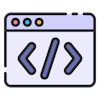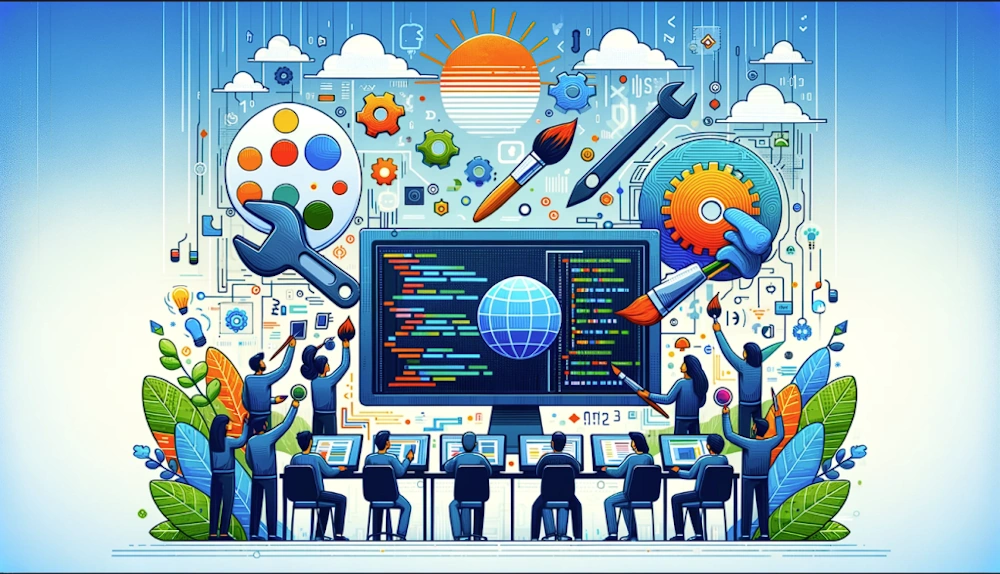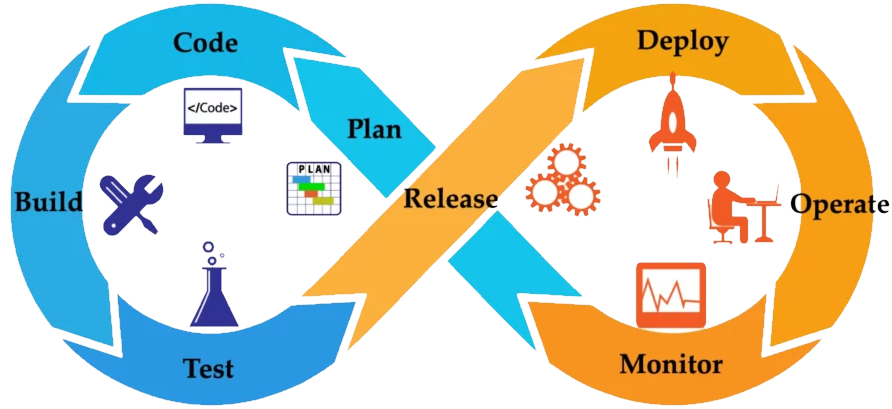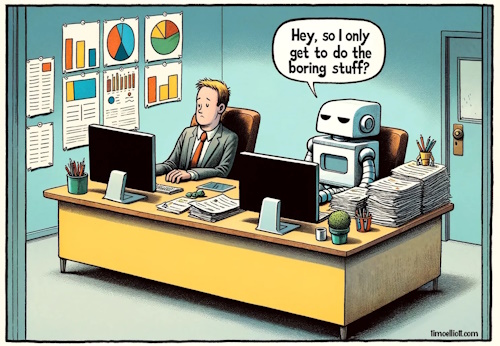 AI in Software
AI in Software
AI is transforming software development with new tools and techniques
Related: AI Industry | AI Companies | AI Stocks
AI is revolutionizing the software development industry by enhancing efficiency, productivity, and innovation through changing how software is created, maintained, and deployed. AI represents a tidal wave, or even a tsunami, of change in a discipline that has been marked by rapid change since its inception.
The software development industry is one of the largest and fastest-growing sectors in the global economy. The industry, defined as the global business software and services market, is valued at over $600 billion and is expected to surpass $800 billion by 2027. Worldwide, there are an estimated 25 million software developers, the core of the industry, and 25% growth is expected over the next five years.
Software development underpins achievements in virtually every industry. It has become the driving force behind advancements in all sectors of the economy, touching practically every aspect of modern life. For example:

Communication and Collaboration
- Messaging Platforms: Applications like WhatsApp, Slack, and Microsoft Teams have enabled instant communication, replacing traditional methods such as letters and phone calls.
- Video Conferencing: Software like Zoom, Google Meet, and Skype has redefined remote work and global collaboration, especially during the COVID-19 pandemic.
- Social Media: Platforms like Facebook, Twitter, and Instagram, powered by sophisticated algorithms, have changed how people interact, share information, and form communities.
Automation and Artificial Intelligence (AI)
- AI-Powered Systems: Software underpins AI technologies like natural language processing in virtual assistants (e.g., Alexa, Siri). Computer vision software drives facial recognition and autonomous vehicles. Predictive analytics software aids decision-making in fields like finance and healthcare.
- Robotics and Automation: Software controls robots used in industries such as manufacturing, agriculture, and logistics, increasing efficiency and reducing human error. RPA (Robotic Process Automation) software automates repetitive business processes like data entry.
Data Management and Analysis
- Big Data: Tools like Apache Hadoop and Spark process massive amounts of data, enabling insights for industries ranging from marketing to genomics. Data visualization software like Tableau and Power BI turns raw data into actionable information.
- Cloud Computing: Cloud platforms (e.g., AWS, Microsoft Azure, Google Cloud) enable secure storage and on-demand access to vast amounts of data. SaaS (Software as a Service) models allow businesses to access complex applications without maintaining costly infrastructure.
Consumer Electronics
- Smartphones and Mobile Apps: Mobile operating systems like Android and iOS support millions of apps, from navigation to fitness tracking. Mobile apps have created entirely new industries, such as ride-sharing (Uber, Lyft) and food delivery (DoorDash, Grubhub).
- IoT Devices: Software connects IoT devices like smart thermostats, wearables, and connected appliances, creating smart homes and cities. Platforms like Google Home and Amazon Alexa integrate multiple IoT devices into seamless ecosystems.
- Gaming: Game engines like Unity and Unreal have transformed gaming into a highly interactive and immersive experience. Software innovations in AR/VR are expanding the possibilities of gaming and training simulations.
Healthcare and Medicine
- Electronic Health Records (EHRs): EHR software allows healthcare providers to maintain comprehensive patient records, improving care coordination and outcomes.
- Medical Imaging and Diagnostics: Software-driven imaging systems like MRIs and CT scans use algorithms to detect diseases with greater accuracy. AI-powered diagnostic tools predict conditions like cancer, diabetes, and heart disease from medical data.
- Telemedicine: Platforms like Teladoc and Amwell enable virtual consultations, expanding healthcare access to rural and underserved areas.
- Drug Discovery: Software simulations and AI accelerate drug discovery by predicting molecular interactions, saving time and costs.
Transportation and Logistics
- Autonomous Vehicles: Self-driving cars rely on software for real-time decision-making, combining AI, sensors, and mapping data. Companies like Tesla and Waymo are leading the charge.
- Navigation and Mapping: Applications like Google Maps and Waze provide accurate, real-time navigation, powered by algorithms that analyze traffic data.
- Logistics Optimization: Software solutions for supply chain management (e.g., SAP, Oracle) streamline operations, reducing costs and delivery times.
Scientific Research and Exploration
- Space Exploration: Software developed by NASA, SpaceX, and ESA controls spacecraft, analyzes data, and enables interplanetary missions. For instance, software powered the Mars rovers (e.g., Perseverance) and the James Webb Space Telescope.
- Simulations and Modeling: Scientific software like MATLAB, ANSYS, and COMSOL enables researchers to simulate physical processes, from climate change to nuclear reactions.
- High-Performance Computing (HPC): HPC software allows for breakthroughs in fields like particle physics (e.g., CERN's Large Hadron Collider) and genomics (e.g., sequencing the human genome).
Security and Cyber Defense
- Encryption Software: Tools like SSL/TLS ensure secure communication over the internet, protecting sensitive data in banking and e-commerce.
- Threat Detection: Cybersecurity software like Norton, McAfee, and CrowdStrike detect and mitigate threats like malware and phishing attacks.
- Blockchain: Blockchain-based software ensures secure, transparent transactions and is increasingly used in finance, supply chains, and digital identity.
Education and E-Learning
- Learning Management Systems (LMS): Platforms like Moodle, Blackboard, and Canvas help schools and universities manage online education.
- E-Learning Apps: Duolingo, Khan Academy, and Coursera enable self-paced learning in various subjects.
- AR/VR in Education: Educational software leverages AR/VR to create immersive experiences, such as virtual field trips and anatomy lessons.
Sustainability and Green Technology
- Energy Management Software: Software optimizes energy usage in buildings and industries, reducing carbon footprints. Applications like Tesla's Powerwall monitor and manage renewable energy storage.
- Environmental Monitoring: Tools powered by AI analyze satellite data to monitor deforestation, track endangered species, and predict natural disasters.
The Software Development Process
The software development process is a structured sequence of stages that software teams follow to plan, design, develop, test, deploy, and maintain software systems or applications. The initial stage is Planning and Requirement Analysis to define the project goals, scope, and requirements. Planning is followed by Designing to create a blueprint for the system architecture and design. The activities in this stage include the system architecture, mapping the hardware and software components, designing the user interface (UI) and user experience (UX), choosing the technologies, tools, frameworks, and programming languages, and planing the database structure, APIs, and integrations. The next stage is Coding in a programming language to translate the design into a functional software application. Here is where developers write and test code for individual modules or components. Once code is written, Testing is performed to ensure the software is functional, reliable, and bug-free. The next stage is Deployment, with the purpose of delivering the software to the end-users or production environment. Finally, once the software is delivered, there is Maintenance and Support, to ensure the software continues to function correctly and adapt to changes. These changes often result in improvements and enhancements which leads to more planning and analysis for future software releases, starting the cycle over again, as illustrated in the following graphic:

Development Tools and Automation
AI tools automate much of the software development process, reducing errors and saving time. Generative AI and large language models can transform ideas into requirements and user stories. AI code generation and completion tools like GitHub Copilot can speed up development by suggesting code snippets or even whole functions based on the context. AI automated debugging can analyze code to predict and identify bugs or suggest fixes, reducing the time developers spend on debugging. AI can automatically generate unit test cases, ensuring better coverage and catching potential issues early in the development cycle. AI can assist in reviewing code for style, security issues, or compliance with best practices, which can be time-consuming for human reviewers. AI tools can automatically generate or update documentation based on code changes to ensure that documentation stays current.
Project Management and Planning
AI can predict the time required for different tasks by analyzing historical data, helping in better project planning and resource allocation. AI can forecast potential risks in software projects, allowing teams to mitigate these before they become issues.
Quality Assurance and Testing
AI-powered systems detect bugs and perform automated testing. AI enhances code quality and reduces human error. AI helps in optimizing Continuous Integration/Continuous Deployment (CI/CD) pipelines by predicting which tests to run based on the changes made, thus speeding up the deployment process. AI can analyze application performance data to suggest optimizations or detect bottlenecks.
 More Areas where AI is Changing Software Development
More Areas where AI is Changing Software Development
- Vulnerability Detection: AI models can be trained to detect vulnerabilities in code or predict where security issues might occur.
- Threat Detection: In real-time systems, AI can help monitor for unusual behavior that could indicate security breaches.
- Meta-Learning: AI is used to develop other AI models, learning how to learn from data more efficiently, which is crucial for creating adaptive systems.
- Automated Machine Learning: This allows for automatic selection of algorithms, tuning of hyperparameters, and even model creation, making machine learning more accessible to those without deep AI expertise.
- Chatbots and Virtual Assistants: AI-driven bots can handle user queries, provide support, or guide users through software interfaces, improving user interaction. AI can personalize user interfaces or suggest features based on usage patterns.
- Enhanced Productivity: AI streamlines workflows and automates repetitive tasks, allowing developers to focus on complex problem-solving and creativity, and improving project management and resource allocation.
- Personalization: AI analyzes user behavior to create more personalized software. AI improves user interfaces and the overall user experience. AI enables the development of intelligent chatbots and virtual assistants, so vital to code development and testing as well as the public at large.
- Predictive Analytics: AI processes vast amounts of data to provide insights for informed decisions. AI enhances project planning and risk assessment and optimizes resource allocation and scheduling.

 Benefits
of AI in Software
Benefits
of AI in Software
- Efficient code generation: AI can aid in automating the creation of code snippets, saving developers time and reducing coding errors.
- Enhanced user experiences: AI-driven applications can analyze user behavior and preferences, enabling the development of more personalized and user-friendly software.
- Automation of repetitive tasks: Mundane and repetitive tasks can be automated, freeing up developers to focus on more innovative and complex aspects of the project.
- Data-driven decision-making: AI can process and analyze vast amounts of data, providing valuable insights for informed decision-making throughout the development process.
- Scalability and flexibility: AI can adapt to changing project requirements and scale resources as needed, making software development more agile and responsive to evolving demands.
 Challenges
of AI in Software
Challenges
of AI in Software
- Ethics and bias: With AI involved in code review or generation, there's a risk of perpetuating bias if not managed properly. The use of AI in may also raise ethical questions regarding data privacy and accountability.
- Skill gap: As AI takes over more routine tasks, developers might need to upskill in AI technologies to stay relevant or to understand and use these tools. AI may reshape agile methodologies and traditional development processes.
- Dependency on AI: There's a risk of over-reliance on AI tools, potentially leading to a decline in human coding skills or understanding of the underlying software systems.
- Data privacy: When AI tools analyze code, there's a need to ensure that proprietary or sensitive information is handled securely.
- Job displacement: The fear of AI rendering software engineers obsolete is a genuine concern, especially in automating repetitive tasks.
- Security vulnerabilities: AI systems themselves may become targets for malicious activities, potentially exposing software to new security risks.
- Training and implementation: Integrating AI into software development can be costly, in time and money, requiring investments in infrastructure, tools, and workforce training.
 Links
Links
AI-Assisted Programming: Better Planning, Coding, Testing, and Deployment
ibm.com/think/topics/ai-in-software-development
onlinecs.baylor.edu/news/will-ai-replace-SWEs
newhorizons.com/resources/blog/benefits-of-ai-in-software-development
scnsoft.com/artificial-intelligence/how-to-develop-ai-software